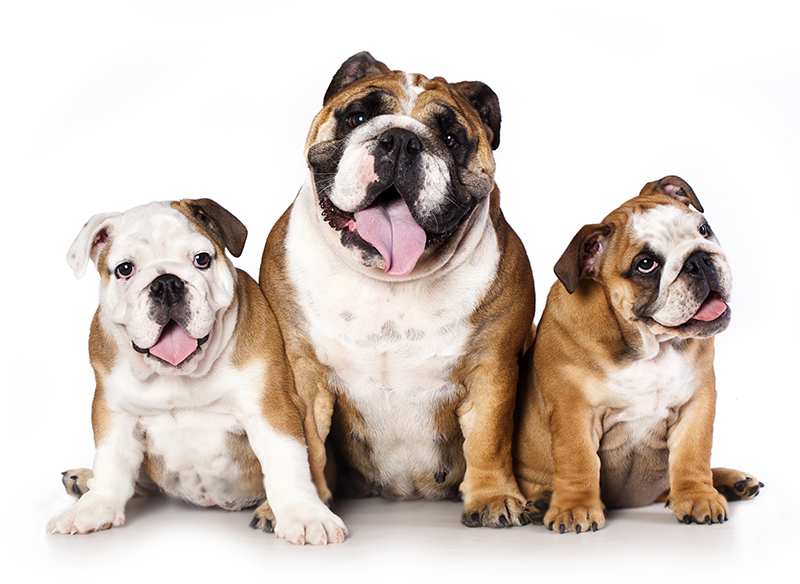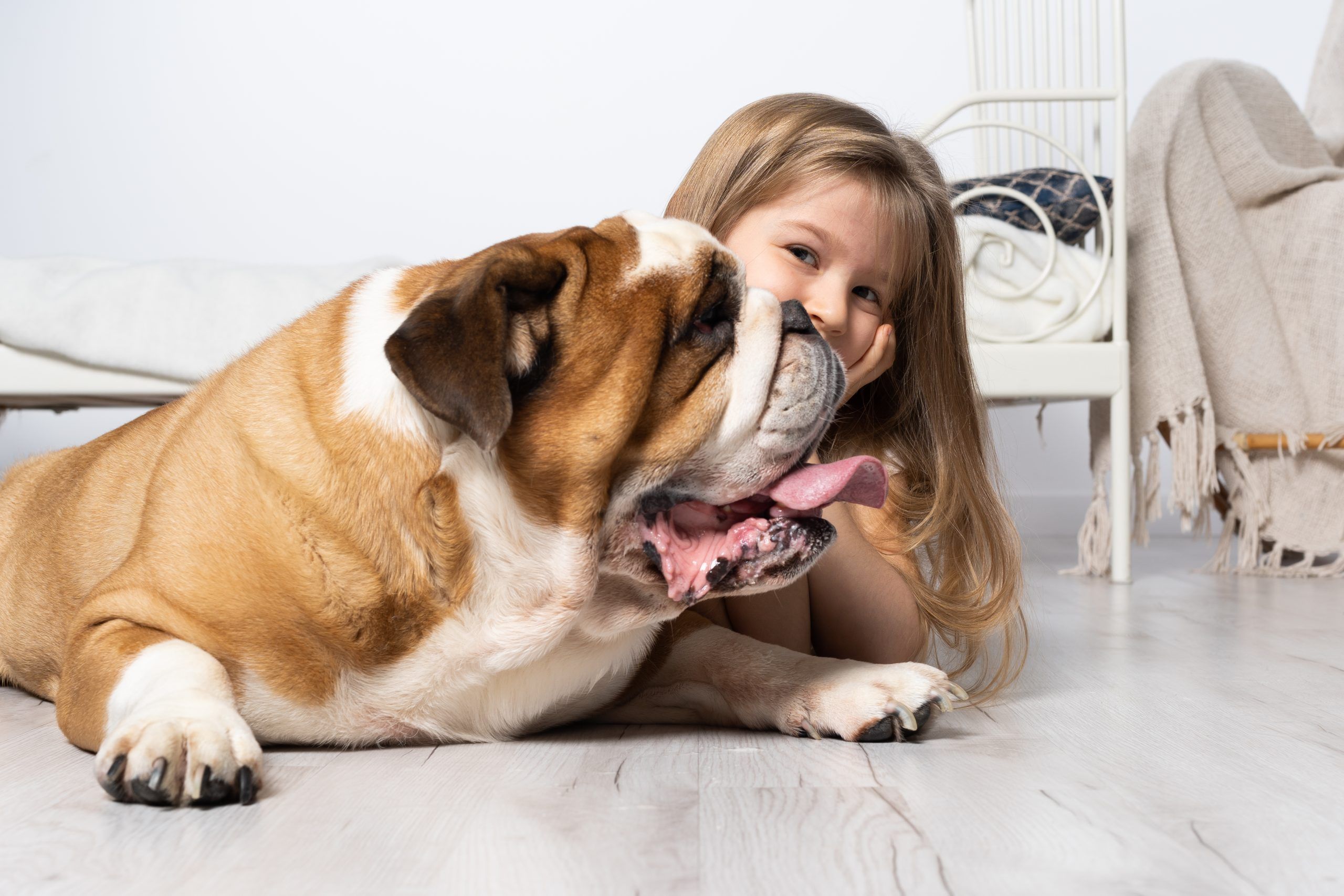British Bulldog


| Recommended for | Families |
| Breed Classification | Non-sporting group |
| Other names | English Bulldog |
| Lifespan | 7-10 years |
| Size | Medium |
| Temperament | Gentle, affectionate, stubborn |
| Intelligence | Average |
| Tendency to bark | Low |
| Maintenance Level | Medium |
| Health Risk | High probability of health issues during its lifetime, hence it is one of the more expensive breeds to insure. |
Insuring a British Bulldog?
Get our award-winning Nose-to-Tail Cover with up to $30k annual benefit limit, up to 90% of eligible vet bills back, and no sub-limits.
Get a quick quote
Is this breed right for you?
Try our breed selector quiz to find out your best matching breed!
Insuring a British Bulldog?
Get our award-winning Nose-to-Tail Cover with up to $30k annual benefit limit, up to 90% of eligible vet bills back, and no sub-limits.
Get a quick quote
Breed history of British Bulldogs
A direct decedent of the ancient Mastiff breeds and thought to have been mixed with Old English Terrier types, the Bulldog was developed entirely in England. The breed was first noted in the 1500s in the description of a man who had ‘two Bolddogges by his side’.
The name ‘Bulldog’ comes from the practice of bull baiting, the task for which the breed was developed. The English believed that if a bull could be tied down and provoked into a rage by a dog, its meat would end up being much more tender and delicious. Additionally, the act of bull baiting was a popular spectator’s sport; sometimes bears would be baited as well, simply for the amusement of the crowd.
When the practice was deemed ‘cruel to animals’ in England in the 1830’s and made illegal, the British Bulldog, as well as a number of English terrier breeds, was swiftly put out of work.
Despite having no apparent purpose in a working dog era, the British Bulldog was still admired by many for its brutish determination and loyalty. Selective breeding followed in order to promote the docile qualities we know today, while retaining the breed’s strength and its traits of loyalty and persistence.
In the 1860’s the British Bulldog began to be entered into dog shows by the new type of breeders, helping to cement its place in the ‘companion dog’ category of our minds.

Physical description of British Bulldogs
The British Bulldog is one of the most recognisable breeds that exists today. It has a low, thickset frame, muscular physic and compact stubby legs. The body is stocky and dense and the head is large and wide, with a relatively short face and broad muzzle.
A hallmark of the breed is the folds of skin that form around the face and forehead of the animal, together with the drooping cheeks that extend from each eye.
The coat is short, smooth and glossy and comes in a variety of colours and patterns.
| Weight range | 23 to 25 kg |
| Height range | 31 to 40 cm |
| Colours | Fawn, red, white, fallow |
| Coat length | Short |

British Bulldog personality and temperament
The British Bulldog is a very persistent yet even-tempered and gentle breed. The breed’s somewhat intimidating appearance and its history of bull baiting are misleading, as the modern English Bulldog is worlds apart from the fighting dog it was originally. The British Bulldog of today has been selectively bred over a few hundred years to serve as a companion animal.
Popular family pets, their gentle but protective nature means that they are very personable and loyal family members that show high levels of affection to their owners. If provoked or threatened by a stranger, they will bravely stand their ground and protect loved ones with determination.
British Bulldogs are very people-orientated and crave human attention at all times. Because they require so much attention they are best suited to a family environment where there will be some contact with people throughout the day. Separation anxiety is common in the breed if they are left alone for an extended period of time.

British Bulldogs with kids and other pets
The British Bulldog has been developed into a docile and very affectionate companion animal, proven to be a wonderful family companion and largely tolerant of other animals.
The breed is especially good with children, being highly affectionate, calm, patient and gentle in play while also being protective and enthusiastic.

British Bulldog training and exercise
British Bulldogs are not overly energetic but are enthusiastic at play time and should be exercised moderately at least once a day. They are best suited to living indoors as they struggle in the heat, especially in an Australian summer, and their short snout can cause laboured breathing in hot and humid conditions. Be vigilant around water as they may struggle to swim.
Good training from a young age, paired with firm and consistent discipline, is a must when owning an British Bulldog. Because the British Bulldog is a stubborn and persistent animal, training can be challenging if not tackled with patience and consistency. They are very loyal animals and are keen to please their owners.
| Energy level | Low |
| Exercise requirements | Moderate |

British Bulldog feeding and nutrition
The British Bulldog should be fed a premium, high-quality dog food appropriate to the dog’s age (puppy, adult, or senior), size and activity level.
British Bulldogs have a tendency become overweight, so a careful diet is required to keep them at a healthy weight. Watch your dog’s calorie consumption and avoid giving too many treats and table scraps.
Check with your vet if you have any concerns about your British Bulldog’s weight or diet.

British Bulldog care and grooming
A good brushing a couple of times per week will keep the British Bulldog coat in good shape, with increased frequency during shedding season.
Be warned – British Bulldogs do tend to drool and need to be wiped as needed to prevent slobber all over the house.
British Bulldogs do tend to have quite a few health issues, and extra care is recommended to prevent forseeable problems from occuring in the first place. Their wrinkles need to be checked daily to ensure they are clean and dry and to avoid skin irritation or infections. Their ears and the area under the tail also need to be kept clean.
Health issues for British Bulldogs
- Cherry Eye is quite common amongst Bulldogs, both English and French varieties. It is a condition in which a third inverted eyelid is present. The condition can be corrected surgically.
- Keratoconjunctivitis Sicca, known more commonly as ‘dry eye’, is usually caused by an autoimmune reaction targeting the animal’s tear glands, resulting in a reduction in the generation of tears. Once diagnosed by your vet, this condition can be easily corrected.
- Brachycephalic Syndrome is common in the British Bulldog and other breeds with shorter, stubby noses. The condition occurs when the airways are obstructed and breathing becomes laboured or near impossible, usually during times of extreme heat. This is most dangerous in summer as the Bulldog will not be able to regulate its body temperature, causing serious complications to health. Surgery to widen the nostrils and shorten palates can help to lessen the severity of the condition.
Not all conditions are covered by Pet Insurance. For details of Bow Wow Meow Pet Insurance cover, refer to the Product Disclosure Statement.
Thinking about insuring a British Bulldog
Thinking about insuring a British Bulldog
Learn moreThinking about insuring a British Bulldog
Learn moreFree engraved pet ID tag on sign up3
Customer Satisfaction
21 day cooling off
Easy to use Pet Portal

GapOnly® in vet claims
MORE INFORMATION
The British Bulldog Club of NSW Inc: http://www.bbcnsw.com/
The British Bulldog Club of Victoria Inc: https://www.bbcov.com/
The British Bulldog Club of South Australia Inc: https://britishbulldogclubsa.com.au/
The Queensland Bulldog Club: https://qldbulldogclub.com/




